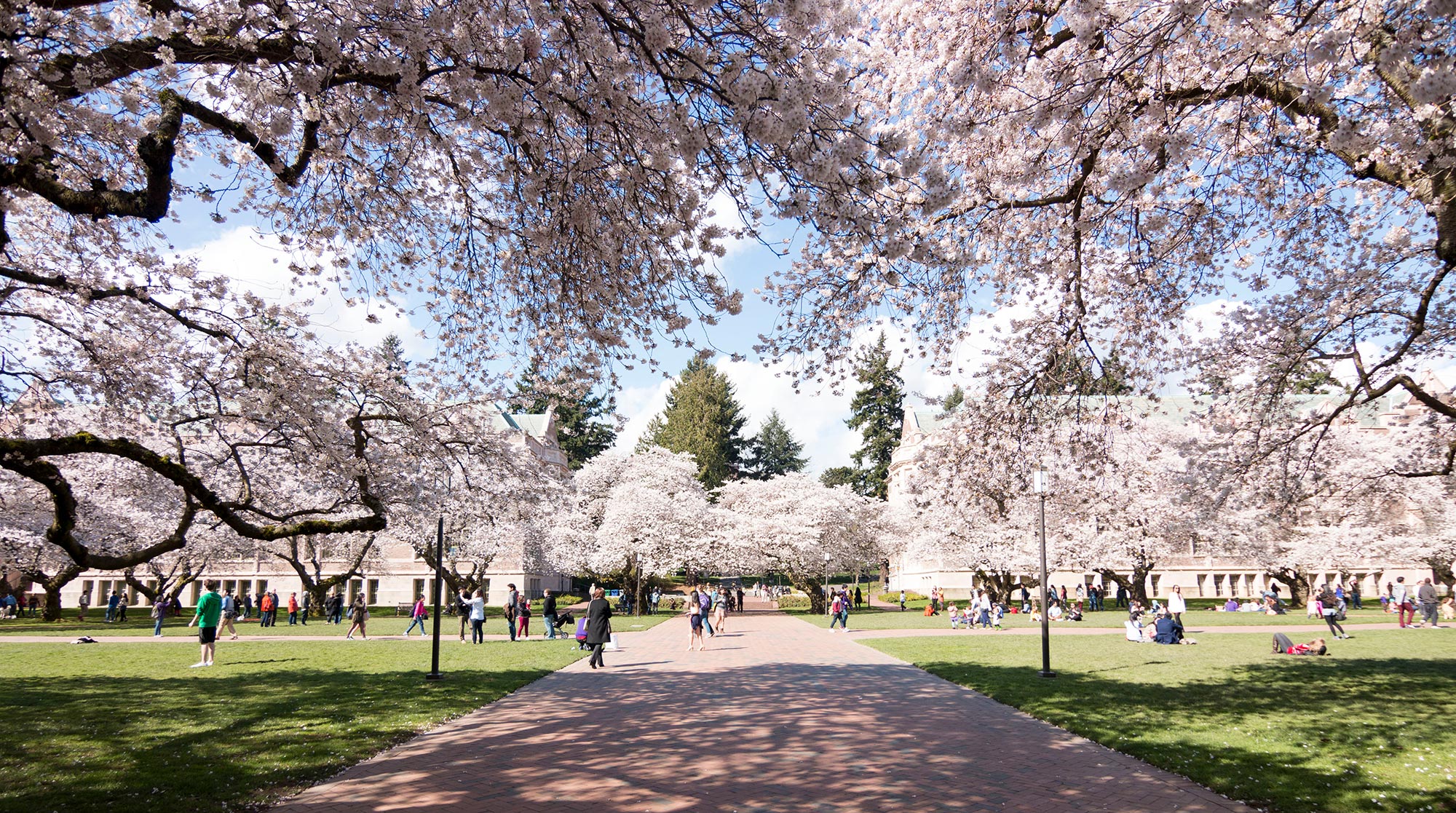

Late this month, just as they have for the last 34 years, 30 Japanese cherry trees will burst into bloom in the University's Liberal Arts Quadrangle—the "Quad."
It is a signature moment in the life of the University. The clouds of rosy pink blossoms will match the color of terra cotta panels on the Collegiate Gothic buildings surrounding them. For a week or two, the Quad will be a fairyland of color, and when the petals fall from the trees, a gentle snow will linger on the lawns and brick walkways.
For recent alumni and current students, these Yoshino cherries look like they have always belonged here. Yet, for its first 70 years, the Quad was an open field, crisscrossed with footpaths that often turned it into a mud flat.
The space was so vast and so bare that the campus ROTC units used it for their marching drills and reviews. Roughly the size of St. Mark’s Plaza in Venice, the Quad was “a big space that didn’t have anything particular to say,” recalls Botany Professor Emeritus Richard Walker.
That barren feeling could return in a few years. The Quad’s cherry trees are aging-two have already died and had to be replaced. Others show signs of decline. Yet the solution is cloudy: No one is sure how long they will survive, and what is the best way to replace them.
It’s a fact of life that trees age and die. “Cherries are a pioneer species,” says UW Arborist Paul Sisson. “They are not a long-lived species.”
“We have to replace them eventually, every single one.”
Bill Talley, UW landscape architect
“We have to replace them eventually, every single one,” adds UW Landscape Architect Bill Talley.
“They are all in decline,” says UW Grounds Supervisor Bonnie Taylor, who was the lead gardener in the Quad for 10 years. “They are temperamental. All fruit trees are that way,” she adds. Cherries don’t handle overly wet conditions very well, she says, and the Quad often has wet, spongy soil.
While the UW has a yearly maintenance schedule that includes spraying with fungicide and cleaning out dead wood and suckers, some trees still show signs of stress. A quick inspection will turn up fungal growth in the trunks of some cherries. Others have large cracks, where there may be damage to the tree’s cambium, its highway for nutrients, Talley warns.
The life span of Prunus yedoensis is 60 to 100 years. Both Talley and Sisson think that the Quad’s cherries are 50 to 60 years old, while Walker says they might even be slightly older. The UW doesn’t have a solid date, because the Quad isn’t the site of their original planting.
More than 116,000 cars a day cross the spot where the cherries were first planted: land that is now the approach to the Evergreen Point Floating Bridge east of Montlake Boulevard. The trees were originally set in a grove as part of the Washington Park Arboretum. (There are two of their “siblings” left where the westbound exit ramp meets Montlake, but they can only be seen from an alley.)
While its pre-war plantings aren’t well documented, Arboretum Registrar Randall Hitchin located a 1939 purchase of 34 Yoshino cherries priced at $1.25 each. Based on the height of the purchased stock, Hitchin estimates they were three years old. That would make the trees 63 years old today.
During highway construction in the early ’60s, the UW’s architect at the time, Fred Mann, drove by the arboretum every morning on his way to work. “Any way we could save those trees, we wanted to do it. We thought it would be terrible if they were dug out and lost,” he recalls. “President Charles Odegaard was very enthusiastic. After all, he drove by those trees himself every morning.”
As Mann recalls, there were many obstacles to the idea. “The tree experts told us it was impossible. The trees were too old and you couldn’t do it,” he says. “There was no guarantee they would survive and it would be expensive.”
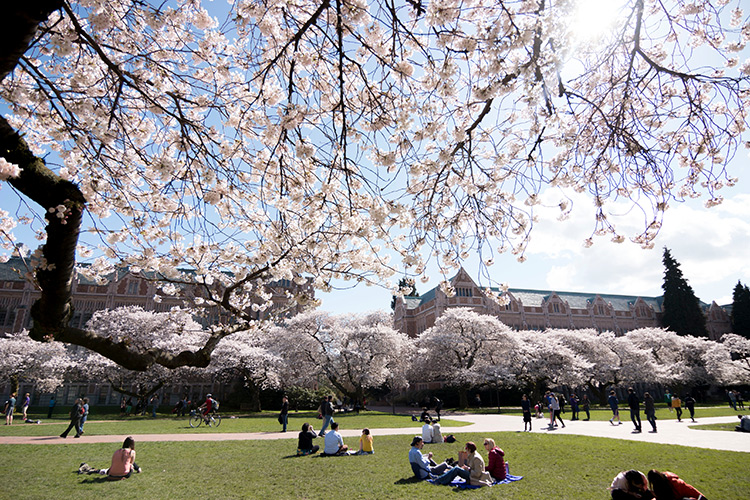
The late Ernest Conrad, the UW’s business and finance vice president, took care of the cost by persuading the state highway department for pay for the move. But the bidding process went slowly, Mann recalls, and by mid-December 1964, bulldozers were standing right next to the cherries. “They were ready to go,” he says.
While arborists told the UW that the roots had to be balled up and the trees delicately replanted, there wasn’t time. “Instead the nurserymen dug them up so that they had only bare roots. They piled them on flatbed trucks like so many pieces of brush,” Mann says. Despite the warnings, “We didn’t lose one tree,” he says.
The 30 cherries were only a tenth of the trees moved that December, recalls Eric Hoyte, who was the UW landscape architect at that time. “We had more than 300 trees to move and they were scattered all over campus.”
There has been some debate on who first suggested that the cherries go into the Quad. In a 1965 Arboretum Bulletin article, Hoyte wrote, “I was given the job of finding new locations for these trees, 30 or more of which were Japanese Yoshino cherries.” But in a recent interview, when asked who came up with the idea, Hoyte replied, “I don’t know.”
In a 1987 letter to the UW faculty/staff newspaper, Business VP Conrad stated, “It was Fred Mann’s suggestion that the cherry trees be located in the Liberal Arts Quadrangle, a suggestion strongly endorsed by President Odegaard.”
Mann doesn’t want the credit and says the issue can never be resolved. “We debated it. It’s hard to know where the initial idea came from. Certainly Charles Odegaard and Ernie Conrad were very much a part of it.”
While the decision to place them in the Quad was shared, the actual design of the planting was Hoyte’s achievement. “The Quad was too large of a space compared with other spaces on campus,” he says.
The stand of cherries could organize the space better and control some of the pedestrian traffic. Rather than just lining up the trees along the buildings, Hoyte chose to cut the Quad into two smaller spaces with a double row of trees planted about three-quarters of the way toward its southern end.
“The formal arrangement of these trees suggests an arcade or cloister, which seems very much in keeping with the Gothic architecture,” he wrote in his 1965 article. “The idea was to try and make smaller spaces and make them more humane,” he adds today. Contrary to one campus legend, the trees were not planted in the shape of a ‘W.’
The cherries were severely pruned after transplanting, probably too much by today’s standards. “Nobody knew whether they’d live or not. They looked like a bunch of dead sticks planted in the ground,” Mann recalls.
But the next March, buds on the trees began to swell and later that month burst into bloom. “There was great glee over that,” Mann remembers. “We did not lose one cherry.”
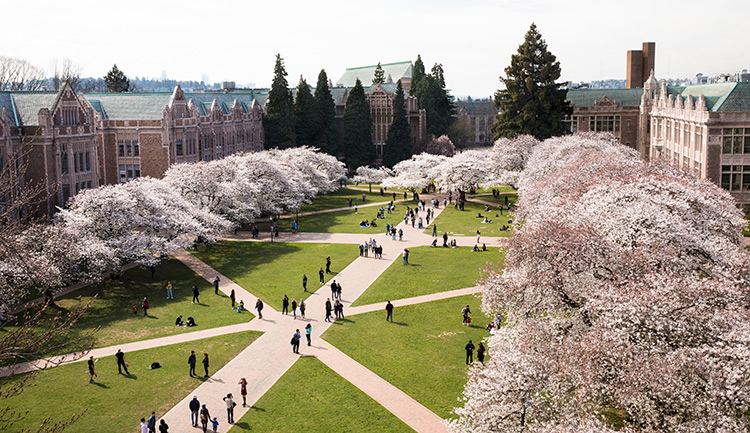
President Emeritus Odegaard’s office in Miller Hall overlooked the setting. After his retirement in 1973, he watched the cherries with proprietary interest. “Every year he would come in and look at those trees in bloom and tell us the story of how they were moved,” says Maggie Patterson, assistant to the dean of education, whose desk was near Odegaard’s office.
As the trees grew in size, Hoyte’s concept became reality. Not only were the March blooms impressive, but the changing leaves in the autumn added variety to the space. What was once a “mud hole” and an ROTC parade ground became a sacred space.
Why does the Quad work as well as it does? Architecture Emeritus Professor Norm Johnston says the unity of the Quad’s architectural framework is one factor. “The landscape treatment deserves much of the credit: the simplicity of its floor of lawns and bricked walks and the ranks of Yoshino cherry trees that parallel its walls.”
“Each season is so different,” says Patterson. “In the spring it’s like a fairyland. When the petals fall, it’s like walking through pink snow.”
During blossom time, she watches tourists and families coming to campus to take in the view. “It’s an impromptu festival. What happens is what the University is all about-it becomes a community.”
No one disputes that the space is a success and that the cherries are a major reason why. (“Those trees have done more goodwill for the UW than anything else we’ve done,” comments Mann.) But there is some debate over how the University is going to replace them in the next 10 to 20 years.
One approach is to replace them piecemeal as the older trees die. This has already happened with two trees in the southeast corner of the Quad, near Smith Hall. Gardeners uprooted the dying cherries, took care to amend the soil, and planted saplings in the same spots.
The danger of direct replanting is that some disease may remain in the soil to attack the new tree, says Talley. So far, signs are good that this is not taking place.
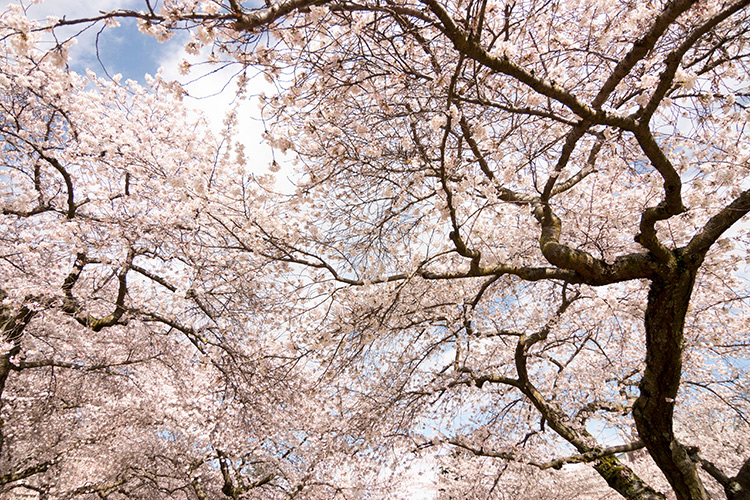
But this piecemeal plan has its critics. The Quad will end up with trees of different sizes at different ages. “If you want an even-aged stand-which is more dramatic-you need to plant them all at once,” notes arborist Sisson.
New trees of the same age could be planted in spaces between the old ones, Sisson explains. When the new plantings are established, the dying trees could be removed. “I’ve been agitating for this for many years,” says Botany Professor Walker, who is a former chair of the UW Landscape Advisory Committee.
“You just don’t know which old ones are going to conk out,” Walker adds. By planting replacements now, between the old trees, the young trees can establish good growth and a large crown. As the older trees die over the next 10 or 20 years, “you could take them out and you’d never notice that they were gone,” he says.
Forest Resources Professor Emeritus Dale Cole currently heads the UW Landscape Advisory Committee. This spring the committee began a major study for the entire campus on replacing its aging trees. “What’s happening in the Quad is an issue that is happening all the way across the campus,” he explains. “Trees mature and they die and they need replacement. One has to look at a long-range plan.”
Cole says the study will take at least a year before recommendations will be sent to Executive Vice President Weldon Ihrig, and a plan for the Quad will be part of the proposal. As for replacing the cherries, Cole favors interplanting now with new saplings. “Then I would take out the mature trees. The uniformity is one thing that makes them impressive, as well as the blooming. But this is a personal opinion only.”
Patterson cringes at the thought of workers chopping down the gnarled cherries. “You want to see them die a natural death,” she says. But being a gardener herself, Patterson adds, “Trees have a cycle. You have to enjoy them for what they are.”
Will there always be Yoshino cherries in the Quad? Unless there is a devastating disease or a drastic change in aesthetics, these trees will always be a part of the University of a Thousand Years. “I used to live in Washington D.C.,” says Patterson. “In the spring I’d visit the cherry trees along the Tidal Basin. But the Quad outdoes that. It’s unexpected. I can’t explain it except to say that it’s magic.”
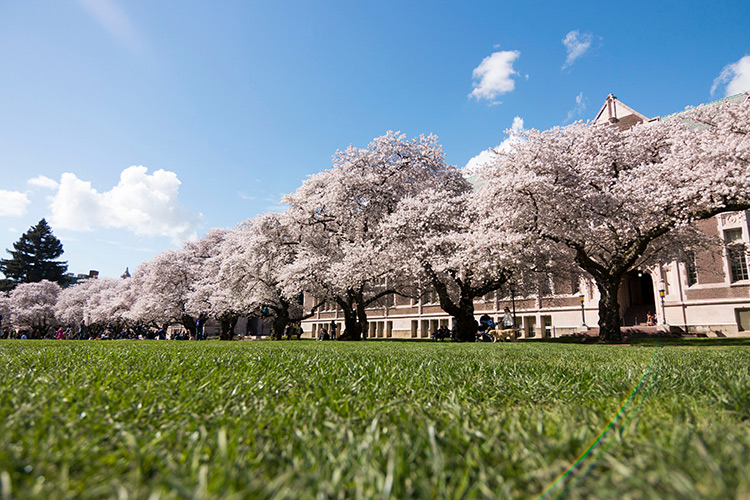
We stand newborn, beneath the cherry trees.
A gift transplanted in mid-life,
within a cloistered mall with blossoms
drifting pink, whose breathing limbs are dying.
Transformed this barren space to sacred,
freed from ROTC boots that march in place
and trample mud. Walkways made of brick replace
dirt paths, to knit these 30 cherry trees
into a fragile dome. In spring each well-pruned, sacred
branch extends its petals, spreading life
while thoughts of winter die
in shadows of Yoshino blossoms.
They brought each tree that blossoms
from Japan, to put into our Arboretum place.
Construction plans pulled transplants dying,
bare roots flung on flat bed trucks to move these trees,
to give them one more chance at life.
Deeply pruned, persisting sacred,
swelling full, into our sacred
refuge soft by terra cotta walls and blossoms.
Where halls of learning sprout new life,
and lovers press their lips in place
beneath Yoshino cherries
long before we ever thought of dying.
But now, we know these trees are dying.
This Quad that holds each fissured trunk, sacred
patterns etched on gnarled cherries,
grieves those we’ve lost, while others blossom.
We keep a vigil on this place
that ages, and still gives us life.
Saplings planted side by side, bring new life,
as one by one we watch our elders dying.
Refusing them to leave this place,
our anniversaries held sacred.
We celebrate each blossomed,
blushing season of these 30 cherry trees.
Trembling blossoms, petals dying,
Swirling sacred into corners of our lives
that shorten as Yoshino cherries leave this place.
—Ann Batchelor Hursey, Seattle